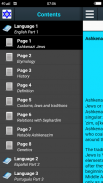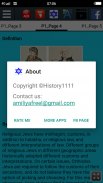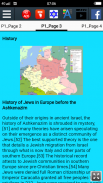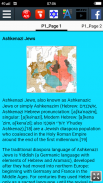








History of Ashkenazi Jews

History of Ashkenazi Jews介绍
Ashkenazi Jews, also known as Ashkenazic Jews or simply Ashkenazim (Hebrew: אַשְׁכְּנַזִּים, Ashkenazi Hebrew pronunciation: [ˌaʃkəˈnazim], singular: [ˌaʃkəˈnazi], Modern Hebrew: [aʃkenaˈzim, aʃkenaˈzi]; also יְהוּדֵי אַשְׁכְּנַז Y'hudey Ashkenaz),[18] are a Jewish diaspora population who coalesced in the Holy Roman Empire around the end of the first millennium.[19]
The traditional diaspora language of Ashkenazi Jews is Yiddish (a Germanic language with elements of Hebrew and Aramaic), developed after they had moved into northern Europe: beginning with Germany and France in the Middle Ages. For centuries they used Hebrew only as a sacred language, until the revival of Hebrew as a common language in Israel. Throughout their time in Europe, Ashkenazim have made many important contributions to its philosophy, scholarship, literature, art, music and science.[20][21][22][23]
The term "Ashkenazi" refers to Jewish settlers who established communities along the Rhine river in Western Germany and in Northern France dating to the Middle Ages.[24] Once there, they adapted traditions carried from Babylon, the Holy Land, and the Western Mediterranean to their new environment.[25] The Ashkenazi religious rite developed in cities such as Mainz, Worms, and Troyes. The eminent French Rishon rabbi Shlomo Itzhaki (Rashi) would have a significant influence on the Jewish religion.
In the late Middle Ages, due to religious persecution, the majority of the Ashkenazi population shifted steadily eastward,[26] moving out of the Holy Roman Empire into the areas later part of the Polish–Lithuanian Commonwealth (comprising parts of present-day Belarus, Latvia, Lithuania, Moldova, Poland, Russia, and Ukraine).[27][28] In the course of the late 18th and 19th centuries, those Jews who remained in or returned to the German lands generated a cultural reorientation; under the influence of the Haskalah and the struggle for emancipation, as well as the intellectual and cultural ferment in urban centers, they gradually abandoned the use of Yiddish and adopted German, while developing new forms of Jewish religious life and cultural identity.[29]
The Holocaust of the Second World War decimated the Ashkenazim, affecting almost every Jewish family.[30][31] It is estimated that in the 11th century Ashkenazi Jews composed three percent of the world's total Jewish population, while an estimate made in 1930 (near the population's peak) had them as 92 percent of the world's Jews.[32] Immediately prior to the Holocaust, the number of Jews in the world stood at approximately 16.7 million.[33] Statistical figures vary for the contemporary demography of Ashkenazi Jews, ranging from 10 million[1] to 11.2 million.[2] Sergio Della Pergola, in a rough calculation of Sephardic and Mizrahi Jews, implies that Ashkenazi Jews make up less than 74% of Jews worldwide.[34] Other estimates place Ashkenazi Jews as making up about 75% of Jews worldwide.[35]
Genetic studies on Ashkenazim—researching both their paternal and maternal lineages—suggest a predominant amount of shared Middle Eastern ancestry, complemented by varying percentages of European admixture. These studies have arrived at diverging conclusions regarding both the degree and the sources of their European ancestry, and have generally focused on the extent of the European genetic origin observed in Ashkenazi maternal lineages.[36] Ashkenazi Jews are popularly contrasted with Sephardi Jews (also called Sephardim), who descend from Jews who settled in the Iberian Peninsula, and Mizrahi Jews, who descend from Jews who remained in the Middle East.
Ashkenazi犹太人,也被称为Ashkenazic犹太人或简称Ashkenazim(希伯来语:אַשְׁכְּנַזִּים,Ashkenazi希伯来语发音:[ˌaʃkənazim],单数:[ˌaʃkənazi],现代希伯来语:[aʃkenazim,aʃkenazi];还有זַזַזַזַזַזַזַזַזַזַז),[18] ]是一个犹太侨民,他们在第一个千禧年结束时在神圣罗马帝国中合并。[19]
阿什肯纳兹犹太人的传统侨民语言是依地语(希伯来语和亚拉姆语的日耳曼语),在他们迁入北欧之后发展起来:从中世纪的德国和法国开始。几个世纪以来,他们只使用希伯来语作为一种神圣的语言,直到希伯来语复兴为以色列的共同语言。在整个欧洲时期,阿什肯纳兹为其哲学,学术,文学,艺术,音乐和科学做出了许多重要贡献。[20] [21] [22] [23]
“德系犹太人”一词指的是犹太定居者,他们在德国西部和法国北部的莱茵河沿岸建立了可追溯到中世纪的社区。[24]在那里,他们改变了从巴比伦,圣地和西地中海进入其新环境的传统。[25]德系犹太人的宗教仪式在美因茨,沃尔姆斯和特鲁瓦等城市发展起来。着名的法国Rishon拉比Shlomo Itzhaki(拉什)将对犹太宗教产生重大影响。
在中世纪晚期,由于宗教迫害,大多数德系人口向东稳定地移动,[26]从神圣罗马帝国迁移到波兰立陶宛联邦的后期部分(包括现今白俄罗斯的部分地区) ,拉脱维亚,立陶宛,摩尔多瓦,波兰,俄罗斯和乌克兰)。[27] [28]在18世纪末和19世纪期间,留在或返回德国土地的犹太人产生了文化重新定位;在哈斯卡拉和解放斗争以及城市中心的知识和文化骚动的影响下,他们逐渐放弃使用意第绪语并采用德语,同时开发新形式的犹太宗教生活和文化认同。[29]
第二次世界大战的大屠杀摧毁了德系犹太人,几乎影响到每个犹太家庭。[30] [31]据估计,在11世纪,德系犹太人占世界犹太人口总数的百分之三,而在1930年(接近人口的高峰期)估计,他们占世界犹太人的92%。[32]就在大屠杀之前,世界上犹太人的数量大约为1670万。[33]阿什肯纳兹犹太人的当代人口统计数字各不相同,从1千万[1]到1120万不等。[2] Sergio Della Pergola粗略计算了Sephardic和Mizrahi犹太人,暗示Ashkenazi犹太人占全世界犹太人的比例不到74%。[34]其他估计认为,德系犹太人占全世界约75%的犹太人。[35]
对Ashkenazim进行遗传研究 - 研究其父系和母系谱系 - 表明共有中东血统的主要数量,并辅以不同比例的欧洲混合物。这些研究得出了关于其欧洲血统的程度和来源的不同结论,并且一般侧重于在德系家族血统中观察到的欧洲遗传起源的程度。[36] Ashkenazi犹太人与Sephardi犹太人(也称为Sephardim)形成鲜明对比,后者来自定居在伊比利亚半岛的犹太人,以及来自留在中东的犹太人的Mizrahi犹太人。























